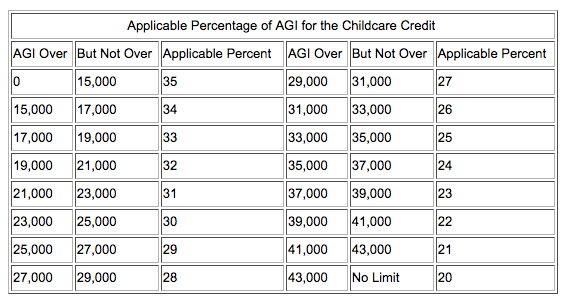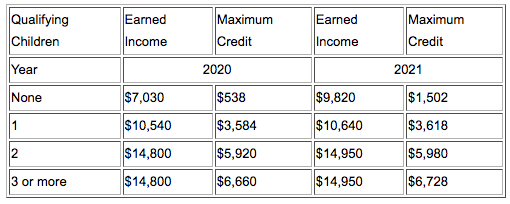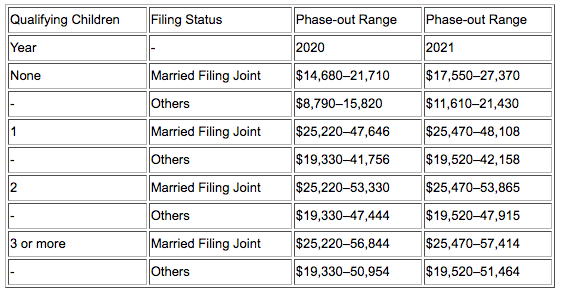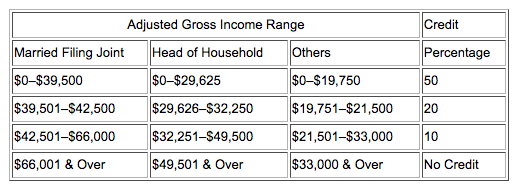Article Highlights:
- Non-refundable vs. Refundable Credit
- Childcare Credit
- Earned Income Tax Credit
- Child & Dependent Tax Credit
- Saver’s Credit
- Vehicle Tax Credits
- Adoption Credit
- Residential Energy-Efficient Property Credit
Tax credits are a tax benefit that offsets your actual tax liability, as opposed to a tax deduction, which reduces your income. Congress provides tax credits to individual taxpayers for a number of reasons, including as a form of assistance for lower-income taxpayers, to stimulate employment, and to stimulate certain investments, among other things.
Tax credits come in two types: non-refundable and refundable. A non-refundable credit can only reduce your tax liability to zero; any excess is either carried forward or is simply lost. In the case of a refundable credit, if there is excess after reducing your tax liability to zero, the excess is refundable. The following is a summary of some of the tax credits available to individual taxpayers:
Childcare Credit
Parents who work or are looking for work often must arrange for care of their children during working hours or while searching for work. If this describes your situation and your children requiring care are under 13 years of age, you may qualify for a childcare tax credit.
For 2020, The credit ranges from 20% to 35% of non-reimbursed expenses, based upon your income, with the higher percentages applying to lower-income taxpayers and the lower percentages applying to higher-income taxpayers.

The maximum expense amount allowed is $3,000 for one child and $6,000 for two or more, and the credit is non-refundable, which means it can only reduce your tax to zero, and the excess is lost.
As an example, say your adjusted gross income (AGI) is between $33,000 and $35,000. Your credit percentage would be 25%. If you paid childcare expenses of $4,000 for two children under the age of 13, your tax credit would be $1,000 ($4,000 x 25%). If your tax for the year was $5,000, the credit would reduce that tax to $4,000. On the other hand, if your tax for the year was $800, the credit would reduce your tax to zero, and the $200 excess credit would be lost.
This credit also applies when a taxpayer or spouse is disabled or a full-time student, in which case special “earned income” allowances are provided for months when the taxpayer or spouse is disabled or a full-time student. Please call this office for additional details if this situation applies in your case.
Credit Increased for 2021 – The American Rescue Plan Act increases the credit percentage to 50%, based on expenses of up to $8,000 for one child under the age of 13 and $16,000 for two or more. The credit begins to phaseout for taxpayers with AGIs of $125,000. Unlike other years, credit is refundable.
Earned Income Tax Credit (EITC)
Congress established the EITC as an income supplement for working individuals in lower-paying employment. If you qualify, it could be worth as much as $6,660 in 2020. It is a refundable credit.
The EITC is based on the amount of your earned income (income from work for wages and/or self-employment) and whether there are qualifying children in your household.
COVID-19 tax relief legislation passed late in 2020 allows you to elect to use your 2019 earned income to figure your 2020 EITC if your 2019 earned income is more than your 2020 earned income.
Qualifying children are those who live with you for over half the year, are related, and are under the age of 19 or a full-time student under the age of 24. The credit increases as your earned income increases. The table below shows the earned income at which the maximum credit is achieved for 2020 and 2021.

The credit amount phases out after reaching the maximum based on filing status and number of qualifying children. The phase-out ranges for 2020 and 2021 are shown in the table below.

In addition, there are some qualification requirements: you, your spouse (if married and filing jointly), and each qualifying child must have a valid Social Security number, and you cannot use the filing status married filing separately. You cannot be a qualifying child of another person, your investment income for 2020 cannot exceed $3,650 ($10,000 in 2021) and you cannot exclude earned income from working abroad. If you do not have a qualifying child, you must be at least age 25 but under 65 at the end of the year. However special rules apply for 2021.
Even though this credit can be worth thousands of dollars to a low-income family, the IRS estimates as many as 25 percent of people who qualify for the credit do not claim it, simply because they don’t understand the criteria. If you qualified for but failed to claim the credit on your return for 2017 (if filed by April 15, 2021), 2018, 2019, and/or 2020, you may still claim it for those years by filing an amended return or an original return, if you have not previously filed. Please call for assistance.
Members of the military can elect to include their nontaxable combat pay in their earned income for the earned income credit. If that election is made, the military member must include in their earned income all nontaxable combat pay they received for the year.
The American Rescue Plan Act – Make a one-year increase in the EITC for childless adults from roughly $530 to $1,502 and to increase the income limit for the credit for these individuals from roughly $16,000 to $21,000. the age cap has been eliminated so that older workers without a qualifying child can claim the credit (currently a childless individual cannot claim the credit after reaching age 65). The legislation also removed the age cap, as well as lower the minimum age to claim the childless EITC from 25 to 19 (except for certain full-time students). Loosened the requirements for child identification numbers for certain childless filers, and for all eligible filers allows 2019’s earned income to be used instead of 2021’s, if 2021’s earned income is less than 2019’s.
Child & Dependent Tax Credit
As an aid to families with children, the tax code provides a child tax credit of $2,000 for each qualified child. A qualified child for this tax credit is one who is under age 17 at the end of the year, is related, is not self-supporting, lived with you over half the year, has a Social Security number, and is claimed as your dependent. The refundable portion of this credit is equal to 15% of your earned income but limited to $1,400.
You are also able to claim a non-refundable credit of $500 for each of your dependents who do not qualify for the child credit.
For both the child and dependent credits, the credit begins to phase out for married taxpayers with an AGI of $400,000 ($200,000 for others).
The American Rescue Plan Act – For a period of one year, 2021, the credit will include children up through age 17 in the credit, increase the Child Tax Credit to $3,000 ($3,600 for children under the age of 6), make the credit fully refundable.
Saver’s Credit
Congress created the non-refundable saver’s credit as a means of stimulating retirement savings among lower-income individuals. It helps to offset part of the first $2,000 that workers voluntarily contribute to traditional or Roth individual retirement arrangements (IRAs), SIMPLE-IRAs, SEPs, 401(k) plans, 403(b) plans for employees of public schools and certain tax-exempt organizations, 457 plans for state or local government employees, and the Thrift Savings Plan for federal employees. The saver’s credit is available in addition to any other tax savings that apply as a result of contributing to retirement plans. The credit is a percentage of the first $2,000 contributed to an eligible retirement plan. The following table illustrates the percentage based upon filing status and AGI for 2021.

Example – Eric and Heather are married, both age 25, and filing a joint return. Eric contributed $3,000 through his 401(k) plan at work, and Heather contributed $500 to her IRA account. Their modified AGI for 2021 was $38,000. The credit is computed as follows:

Vehicle Tax Credits
If you are considering purchasing a new car or light truck (less than 14,000 pounds), don’t overlook the fact that Congress allows a substantial tax credit for the purchase of the many electric vehicles currently being offered for sale, providing a tax credit worth as much as $7,500.
To be eligible for the credit, you must acquire the vehicle for use or lease and not for resale. Additionally, the vehicle’s original use must commence with you, and you must use the vehicle predominantly in the United States.
Congress did include a phase-out provision for this credit that applies by vehicle manufacturer. The credit begins to phase out once the manufacturer sells 200,000 electric vehicles. To see if the make and model you are considering qualify, visit the IRS website.
The credit is available whether you use the vehicle for business, personally, or a combination of both. The prorated portion of the credit that applies to business use becomes part of the general business credit, and any amount not used on your return for the year when you purchase the vehicle can be carried back to the previous year and then carried forward until used up, but for no more than 20 years. The personal portion is non-refundable.
Adoption Credit
If you are an adoptive parent or are planning to adopt a child, you may qualify for the adoption credit. The amount of the credit is based on the expenses incurred that are directly related to the adoption of a child under the age of 18 or a person who is physically or mentally incapable of self-care.
This is a 1:1 credit for each dollar of qualified expenses up to the maximum for the year, which is $14,440 for 2021 (up from $14,300 for 2020). The credit is non-refundable, which means it can only reduce your tax liability to zero (as opposed to potentially resulting in a cash refund). But the good news is that any unused credit can be carried forward for up to five years to reduce your future tax liability.
Qualified expenses generally include adoption fees, court costs, attorney fees, and travel expenses that are reasonable, necessary and directly related to the child’s adoption, and they may be for both domestic and foreign adoptions; however, expenses related to adopting a spouse’s child are not eligible for this credit. When adopting a child with special needs, the full credit is allowed, whether or not any qualified expenses were incurred.
The credit is phased out for higher-income taxpayers. For 2021, the AGI (computed without foreign-income exclusions) phase-out threshold is $216,660, and the credit is completely phased out at the AGI of $256,660. Unlike most phase-outs, this one is the same regardless of filing status. However, taxpayers filing as married filing separately cannot claim the credit.
Residential Energy Efficient Property (Solar) Credit
This tax credit was created to reward individuals for investing in equipment that uses alternative energy sources to create electrical power for use in a taxpayer’s home or second home. It includes alternative power sources such as fuel cells, wind energy, and geothermal heat pumps, for which the credit expires after 2021.
However, the credit is most commonly associated with the home solar credit, which is equal to 26% of the cost of the solar electric system for an individual’s primary and second homes, with no limit on the cost of the solar system. Even though the credit is non-refundable, any amount not used in the first year carries over to subsequent credit years.
The credit percentage is phased-out as shown in the table.

Before deciding to add a solar electric system to your home, you need to consider if you can actually afford the system and whether it is worth having one, after taking into account the system’s cost, the financing interest, the reduced electricity costs, and the tax credit. You should make an objective analysis without pressure from a salesperson. These credits are substantial, but the one thing salespeople and contractors typically fail to mention is that the credit is not refundable, and even though it carries over through 2023, there is a good chance you will never use it all. It may be appropriate for you to consult with this office before entering into a contract for a home solar system.
Electric Motorcycle Credit
Taxpayers that purchase a qualifying electric 2-wheel motorcycle will qualify for a non-refundable credit equal to 10% of the cost, maximum credit $2,500 per vehicle. A qualifying vehicle must meet the following requirements.
- Propelled by a rechargeable battery with a capacity of at least 2.5 kilowatt hours,
- Capable of being re-charged from an external source,
- Highway vehicle capable of 45 mph or more,
- Manufactured primarily for use on public streets, roads and highways,
- Gross weight is less than 14,000 pounds,
- Original use (lease or purchase) begins with the taxpayer, acquired after 2014 and before 2022.
If you have questions or would like additional details related to any of these credits, please give the office a call.




